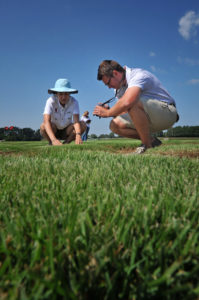Nematodes in Turf
go.ncsu.edu/readext?655602
en Español / em Português
El inglés es el idioma de control de esta página. En la medida en que haya algún conflicto entre la traducción al inglés y la traducción, el inglés prevalece.
Al hacer clic en el enlace de traducción se activa un servicio de traducción gratuito para convertir la página al español. Al igual que con cualquier traducción por Internet, la conversión no es sensible al contexto y puede que no traduzca el texto en su significado original. NC State Extension no garantiza la exactitud del texto traducido. Por favor, tenga en cuenta que algunas aplicaciones y/o servicios pueden no funcionar como se espera cuando se traducen.
Português
Inglês é o idioma de controle desta página. Na medida que haja algum conflito entre o texto original em Inglês e a tradução, o Inglês prevalece.
Ao clicar no link de tradução, um serviço gratuito de tradução será ativado para converter a página para o Português. Como em qualquer tradução pela internet, a conversão não é sensivel ao contexto e pode não ocorrer a tradução para o significado orginal. O serviço de Extensão da Carolina do Norte (NC State Extension) não garante a exatidão do texto traduzido. Por favor, observe que algumas funções ou serviços podem não funcionar como esperado após a tradução.
English
English is the controlling language of this page. To the extent there is any conflict between the English text and the translation, English controls.
Clicking on the translation link activates a free translation service to convert the page to Spanish. As with any Internet translation, the conversion is not context-sensitive and may not translate the text to its original meaning. NC State Extension does not guarantee the accuracy of the translated text. Please note that some applications and/or services may not function as expected when translated.
Collapse ▲ Nematode damage manifests itself in both above and below ground symptoms. Above-ground symptoms typically include thinning, wilting or death of turfgrass. These symptoms usually occur in irregularly shaped patches that will spread outwards slowly over time if left untreated. Root-knot nematode symptoms often emulate several fungal diseases and can cause chlorotic patches in turfgrass stands.
Nematode damage manifests itself in both above and below ground symptoms. Above-ground symptoms typically include thinning, wilting or death of turfgrass. These symptoms usually occur in irregularly shaped patches that will spread outwards slowly over time if left untreated. Root-knot nematode symptoms often emulate several fungal diseases and can cause chlorotic patches in turfgrass stands.
Below-ground symptoms on turfgrasses include short, stubby root systems. Dark lesions on roots are characteristic of nematode feeding damage, particularly near the root tips. Damage typically occurs at the root tips resulting in a blunted root system and the absence of feeder roots. Root-knot nematodes cause galling on turf similar to other crops, although the galls are smaller and can be difficult to identify properly without the aid of magnification, i.e., hand lens, dissecting microscope, etc.
Sting nematodes start feeding when soil temperatures in the spring are between 50-60○F. Symptoms typically develop early to mid-summer due to damage from feeding in the spring months. Populations of root-knot nematode increase in late-April to early-May and remain elevated through the summer months. Lance nematode population dynamics are unknown.
Nematodes will continue to feed throughout the spring, summer, and fall. Feeding and reproduction are most prevalent in the spring, but root-knot nematode still actively reproduces through the summer. Root-knot nematode produces numerous generations that may require more than 1-2 applications to be effective. Nematode activity subsides as temperatures rise above 90○F. Nematode feeding can predispose turfgrass plants to Pythium root rot (Pythium spp.) and other root diseases due to a compromised root system.
Chemical control may be required to manage nematode populations in order to reduce their impact on turfgrasses. New nematicides are safer for both human and environmental health than past nematicides, but they still must be applied with care. The long-time standard, Nemacur (fenamiphos), has been banned from all use in October 2017. For that reason, it is not included below.
The application of nematicides is recommended from March-June. Applications shouldn’t be made until soil temperatures in the spring are consistently above 50-60○F for sting nematode. In our research, 1-2 well-timed applications are sufficient for sting nematode management. Root-knot nematode, however, produces numerous generations that may require more than 1-2 applications to be effective. Applications in mid- to late summer are likely ineffective as the root damage was done in the spring months and populations are deeper in the soil profile than nematicides can reach. Some products, such as Indemnify (fluopyram), have a long residual and may be effective if applied in the early fall.
All nematicide applications must be irrigated immediately after application with 1/8 to 1/4″ of water to be most effective. Furthermore, our research has shown that applying wetting agents every 2-3 weeks enhances the efficacy of nematicides.
Nematicides should be chosen for use based upon the previous sampling for species as each one doesn’t control all nematodes that may be present. Multiple nematicides may be necessary in rotation to avoid selecting for certain species and for resistance management. Proper sampling is done by taking multiple soil cores around the edge of the damaged area no deeper than 6”. Approximately 10-20 cores are necessary for a sample. Samples should be sent to the N.C. Department of Agriculture and Consumer Services’ Nematode Assay Lab for identification. If sampling for maintenance purposes, sampling an entire area in a zig-zag fashion will provide a good representation of the entire area.




